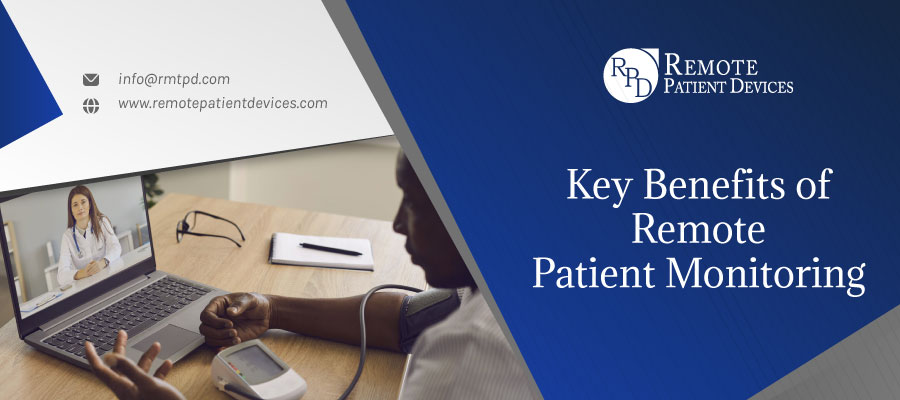
There are scores of benefits that remote patient monitoring brings for both patients and healthcare providers. RPM can help patients manage their chronic conditions more effectively while also reducing the number of doctor’s visits and hospitalizations. This can lead to significant cost savings for patients and the healthcare system. In addition, Remote Patient Monitoring in USA can improve patient outcomes by providing real-time data that can be used to identify problems early and intervene before they become serious.
Remote Patient Monitoring for Providers & patients is a growing trend in the healthcare industry, due to the numerous benefits it provides to both patients and providers. RPM Programs offers patients the opportunity to receive care in their own homes, without having to travel to a medical facility. This is especially beneficial for those with chronic conditions or who live in rural areas.
RPM for Patients also allows them to be more involved in their own care, as they can monitor their own health data and communicate with their provider as needed. RPM has been shown to improve patient outcomes, as well as provider satisfaction.
In the past decade, the medical device industry has seen a major shift towards Remote Patient Monitoring (RPM). Developers of RPM Devices are competing to provide the best remote health monitoring technology to a growing number of patients and physicians. The goal of RPM Services is to improve patient care by providing real-time data to physicians so they can make informed decisions about a patient’s health. RPM devices are used to monitor a variety of conditions, including heart rate, blood pressure, and blood sugar levels.
Remote Patient Monitoring Devices have been shown to improve patient outcomes. A recent study found that RPM devices reduced hospitalizations by 21% and emergency department visits by 15%. RPM devices are also cost-effective. The same study found that RPM devices saved $2,000 per patient per year. RPM devices are not just for patients with chronic conditions. RPM devices are also being used to monitor pregnant women and newborns.
According to the Centers for Disease Control and Prevention (CDC)-1, the cost of chronic health conditions in the United States is estimated to be $3.5 trillion. This amount represents approximately 17% of the country’s Gross Domestic Product (GDP). The CDC estimates that chronic health conditions are responsible for 7 of every 10 deaths in the United States each year.
The cost of chronic health conditions varies depending on the condition and its severity. Some chronic health conditions, such as diabetes, can be managed with lifestyle changes and medication, while others, such as cancer, may require more extensive and expensive treatments. In addition, the cost of chronic health conditions can vary depending on the country in which you live.
There are many financial Benefits of using Remote Patient Monitoring. RPM can help to reduce healthcare costs, improve patient outcomes, and increase patient satisfaction. RPM can help to reduce healthcare costs in a number of ways.
First, RPM can help to reduce hospital readmissions. Hospital readmissions are costly, and they often occur because patients do not receive the proper follow-up care after they are discharged from the hospital. RPM can help to ensure that patients receive the proper follow-up care, which can reduce the likelihood of readmission.
Second, RPM can help to reduce the length of hospital stays. Long hospital stays are costly, and they often occur because patients do not receive the proper care after they are discharged from the hospital. RPM can help to ensure that patients receive the proper care, which can reduce the length of hospital stays.
Further, there are many financial benefits to Remote Patient Monitoring. Perhaps the most obvious is that it can help to save on healthcare costs by reducing the need for frequent in-person visits to the doctor or hospital. Additionally, it can help to improve patient outcomes by allowing for more timely and accurate diagnosis and treatment of conditions. Also, remote patient monitoring can help to improve patient compliance with treatment regimens, which can lead to better health outcomes and lower healthcare costs. This will result in lots of stress and release of focus.
There are many potential benefits of remote patient monitoring for the U.S. healthcare system. These benefits include improved patient outcomes, decreased hospital readmissions, reduced healthcare costs, and improved patient satisfaction.
Improved patient outcomes are one of the most important benefits of remote patient monitoring. This is because patients who are monitored remotely are more likely to receive timely and effective care. In addition, remote patient monitoring can help to identify potential problems early, before they become more serious.
Decreased hospital readmissions is another important benefit of remote patient monitoring. This is because patients who are monitored remotely are less likely to need to be readmitted to the hospital. This can lead to reduced healthcare costs and improved patient satisfaction.
Reduced healthcare costs is a significant benefit that RPM is providing to US healthcare system. The high cost of chronic care management for USA made it essential to reduce the costs using advance technology and RPM.
Improved patient satisfaction is another important benefit of Remote Patient Monitoring. This is because patients who are monitored remotely feel more connected to their care team and feel like they are receiving better care.
Remote Patient Monitoring is a win-win for everyone involved. Patients benefit from improved care. Physicians benefit from real-time data. And, healthcare systems benefit from cost savings. Finally, remote patient monitoring can help providers build stronger relationships with their patients. By staying in touch with them and monitoring their health, they can show them that they care about their well-being and are invested in their health.